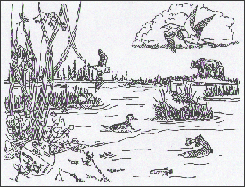| |
|
Marshes 
Marshes can fill broad, flat areas or be contained in tiny pockets surrounded by higher land. They are often found on the edges of ponds, lakes, or rivers. Often a saltwater marsh is associated with an estuary, the place where the freshwater of a river mixes with the saltwater of the ocean. If there is a stream or other water movement through a marsh, nutrients are brought with the water flow. When water drains from a marsh, it carries nutrients to the next wetland or to the ocean.
Marshes are open, wet, grassy areas. There are two kinds of marshes: inland freshwater and coastal saltwater. The inland marshes obtain freshwater from creeks and streams or directly from rain and snow. Tides regularly bring a source of saltwater to the coastal marshes. Both inland freshwater marshes and coastal saltwater marshes have plants that are adapted to the type of water in the marsh. On a windy day marsh plants rustle with their own unique music. The plants that grow in a marsh are special. Their roots are always under the water. Their stems and leaves rise out of the water into the air and sunlight. Marsh plants grow where water is shallow and slow moving. Some marsh plants of western North America include sedges, rushes, and grasses. That's why a marsh looks like a wet meadow. Marshes also have small shrubs and delicate flowering herbs.
Insects, snails, and other small animals thrive among the plants in the slow-moving water. Fish and aquatic insects find shelter among the underwater parts of the plants. Young salmon start their lives in freshwater far upstream. Before they graduate to the ocean, they need time to adapt to saltwater. Coastal saltwater marshes are the perfect place to do that. Shorebirds and other birds can find lots of food to eat in a marsh. They can hide in the tall grass from predators. Have you ever seen a Common Snipe, a Yellowlegs, a Dowitcher, or a Phalarope in a marsh?
|
|
|
|
